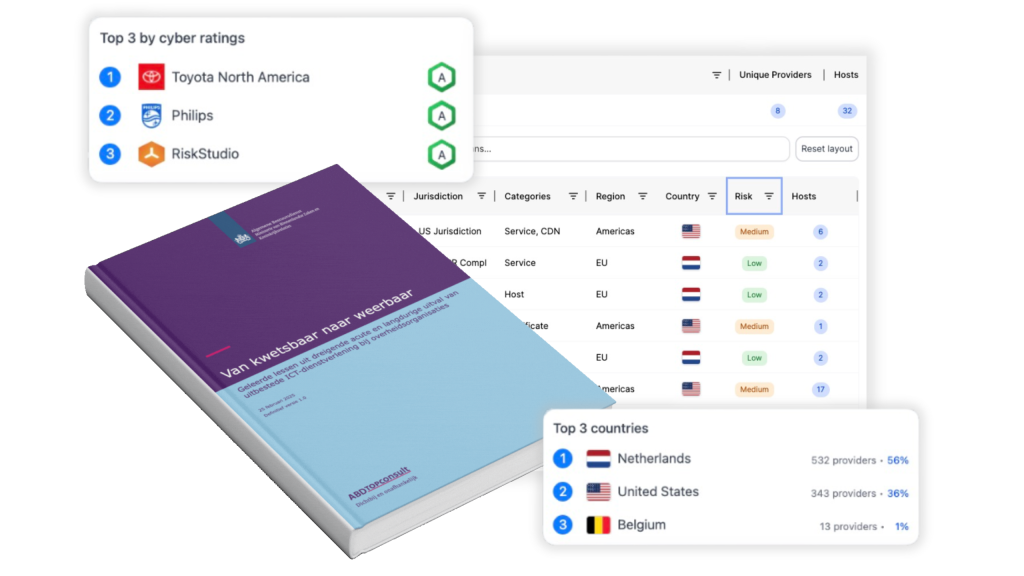Incorporating cyber ratings into your annual reports isn’t just about ticking a compliance box—it’s about demonstrating accountability, resilience, and forward-thinking in a digital-first world.
As cyber threats grow increasingly sophisticated, businesses must address cybersecurity as a fundamental part of their operations. This shift is particularly relevant for companies in Europe subject to the NIS2 Directive or accountancy standards requiring the inclusion of cyber risks in continuity planning. But how can businesses effectively communicate their cybersecurity posture to stakeholders?
Cyber ratings provide a clear, quantifiable way to showcase your organization’s risk management efforts. Let’s explore why integrating cyber ratings into your annual reports is a vital step for enhancing transparency, meeting compliance obligations, and strengthening stakeholder trust.
What are cyber ratings?
Cyber ratings are automated assessments of an organization’s IT infrastructure, including domains, IP addresses, web services, and more. They offer an objective, data-driven measure of cybersecurity performance, benchmarked against industry peers or internal targets.
With solutions like RiskStudio Cyber Ratings, businesses can monitor their suppliers, visualize dependencies, and stay informed about critical incidents affecting their supply chain. These ratings not only ensure your business is secure but also provide a compelling narrative for stakeholders in annual reports.
The importance of Cyber Ratings in annual reports
Including cyber ratings in your annual reports is a powerful way to demonstrate your organization’s commitment to cybersecurity. As businesses face increasing regulatory requirements and heightened stakeholder expectations, these ratings provide a clear, data-driven perspective on your risk management efforts.
1. Meet regulatory expectations
With regulations like the NIS2 Directive requiring businesses to formalize cybersecurity measures, annual reports are becoming a focal point for demonstrating compliance. Cyber ratings provide tangible proof of your company’s adherence to these requirements, reducing regulatory risks.
2. Enhance transparency and trust
Investors, customers, and partners increasingly scrutinize cybersecurity as a measure of operational stability. Including cyber ratings in your annual report signals that your business is proactive about managing risks, fostering trust with stakeholders.
3. Benchmark performance against peers
Cyber ratings allow companies to compare their cybersecurity performance against industry standards, geographic norms, or internal benchmarks. Sharing these insights in annual reports shows your commitment to continuous improvement.
4. Align with Strategic Goals
Annual reports often highlight a company’s vision and long-term objectives. By tying cyber ratings to business outcomes, you can showcase how cybersecurity supports broader goals like digital transformation or sustainable growth.
5. Highlight Supplier Risk Management
Supply chain vulnerabilities can directly impact business operations. Cyber ratings make it easy to demonstrate how your organization monitors and mitigates supplier risks, turning potential weaknesses into strengths.
How to include cyber ratings in annual reports
Effectively incorporating cyber ratings into your annual report can help communicate your organization’s cybersecurity posture in a clear and impactful way. By presenting this data strategically, you not only meet compliance requirements but also highlight your proactive approach to managing risks and supporting business goals. From showcasing improvements to benchmarking against industry standards, there are several ways to make cyber ratings an integral part of your reporting. Here’s how you can seamlessly include cyber ratings in your annual report.
Provide a snapshot of your rating
Include an overview of your company’s current cyber rating, explaining the methodology behind it and its significance.Highlight key improvements
Share year-over-year improvements or specific actions taken to address vulnerabilities, demonstrating progress.Discuss strategic alignment
Explain how cybersecurity investments align with your company’s strategic priorities, reinforcing its role as a value driver.Emphasize supply chain resilience
Use supplier ratings to show how your organization manages external risks and ensures continuity.Include benchmarking data
Compare your rating to industry standards or geographic averages, highlighting your company’s position in the market.
RiskStudio: Simplifying Cyber Ratings for businesses
With RiskStudio Cyber Ratings, your organization can easily monitor its cybersecurity posture and share meaningful insights in your annual report. Our platform offers daily refreshed ratings, detailed transparency into findings, and actionable insights for improvement.
Whether you’re meeting regulatory demands or enhancing stakeholder confidence, RiskStudio provides an affordable, scalable solution tailored to Europe’s mid-market businesses.
Popular Questions
Cyber ratings enhance stakeholder trust by providing an objective measure of cybersecurity performance. They showcase transparency and a commitment to managing risks.
They provide evidence of adherence to cybersecurity standards, such as the NIS2 Directive, demonstrating your organization's commitment to compliance.
Supply chain risks can significantly impact business operations. Highlighting supplier monitoring efforts in annual reports shows a proactive approach to managing these risks.
With RiskStudio, it’s cost-effective and charged per monitored company per month, so businesses can affordably monitor their entire supply chain. You can find full pricing in the pricelist.
Conclusion
In today’s risk-laden digital landscape, cyber ratings are more than just technical metrics—they are a vital tool for showcasing resilience, meeting compliance, and building trust. By integrating cyber ratings into your annual reports, you ensure your company stands out as a responsible, forward-thinking leader in its industry.






